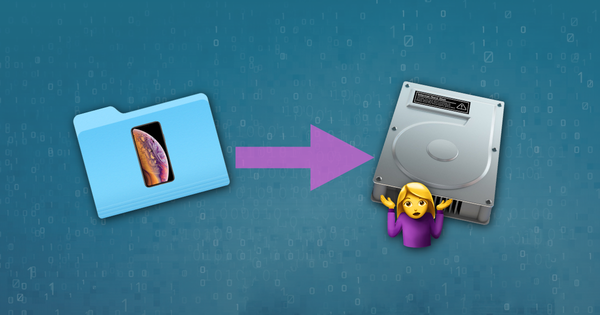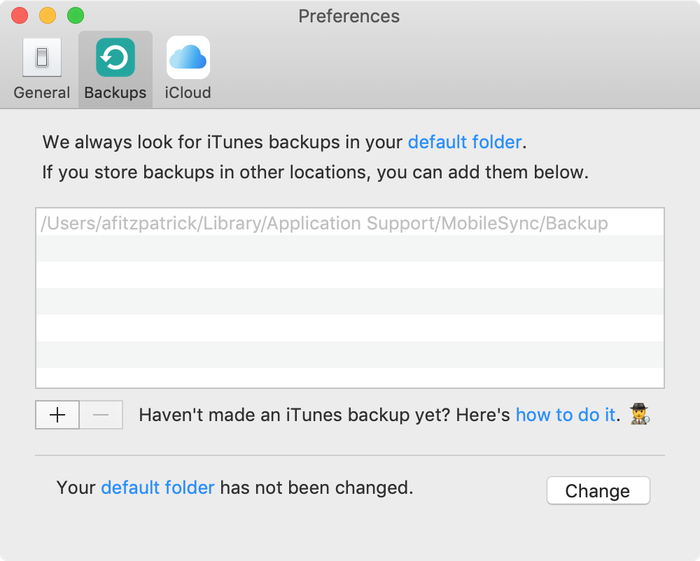How To Change Where Iphone Backs Up
How to change the iTunes backup location

The default iTunes backup location is set to the PC or Mac's primary disk, and in macOS 10.15, iOS backups as created by Finder are stored in the same place. Many users have large backups or backups from a number of iOS devices, and as a consequence they find themselves running low on disk space.
It is possible to configure a computer such that iTunes backs up to a secondary hard-disk, or to an external HDD or NAS.
Simply put, this is done by replacing the iTunes backup folder with a symbolic link to the desired location. This is an easily reversible change, so it is possible to restore the default backup location to its original directory.
Please note that if the iTunes backup location is changed to a volume that is not available at all times, the iTunes backup process will fail when the new location is unavailable.
What you'll need
In order to change your computer's default iTunes backup location, the following is necessary:
- Medium competency with a PC or Mac
- 10 minutes
- An understanding of the desired new backup location path
- A Mac running macOS 10.7 or newer, or a PC running Windows Vista or newer
- The Reincubate support team are on hand to help, and can advise customers on how to do this.
Changing the iTunes iOS backup folder automatically
The free version of iPhone Backup Extractor will automatically show you your computer's default iTunes backup location -- and let you change it.
- Download and install iPhone Backup Extractor.
- Choose
Preferencesfrom the main menu - Select
Backupsfrom thePreferenceswindow
The "Preferences" pane showing backup locations - Click the
Changebutton to start the process of changing your iTunes default backup folder.
Manually changing the iTunes iOS backup folder on Windows
- Open the default Backup location in Explorer using the Windows Run command. Press
⊞ Win+Rand the Run window should appear. Enter%APPDATA%\Apple Computer\MobileSyncand press⏎ Enter. - The Explorer window that opens will show a folder named "Backup". This contains any iTunes backups which are already present on the computer. In order to change the backup folder's location, this folder must be renamed, moved or deleted. As an example, one could rename it to "Backup (Old)".
- Once the "Backup" folder has been renamed, moved or deleted, a symbolic link can be created to the desired backup location. In order to do this, a Command window must be opened. By holding
⇧ Shiftand right-clicking in the recently openedMobileSyncExplorer window, users will see a menu with the option "Open command window here" or "Open PowerShell window here". Click that. - Use the following command
mklink /d Backup "[desired-new-backup-path]". Once this command has been entered, press⏎ Enterand the change will be complete. - After restarting Windows, iTunes will store its backups in the new location.
Manually changing the iTunes iOS backup folder on macOS
- Launch the macOS Terminal application. This can be found using Finder, under
Applications / Utilities / Terminal. Alternatively, it can be launched using Spotlight by pressing⌘ Cmd+and typing "Terminal" before pressing⏎ Enter. - Instruct the Terminal to change to the default iTunes backup location, by entering
cd ~/Library/Application\ Support/MobileSyncand then pressing⏎ Enter. - Reveal the current backup folder in Finder by entering
open .and then pressing⏎ Enter. - The Finder window that opens will show a folder named "Backup". This contains any iTunes backups which are already present on the computer. In order to change the backup folder's location, this folder must be renamed, moved or deleted. As an example, one could rename it to "Backup (Old)".
- Once the "Backup" folder has been renamed, moved or deleted, a symbolic link can be created to the desired backup location. Use the following command
ln -s [desired-new-backup-path] ~/Library/Application\ Support/MobileSync/Backup. Once this command has been entered, press⏎ Enterand the change will be complete. - After restarting the Mac, iTunes will store its backups in the new location.
How to restore the iTunes backup folder to its original location
If you've taken the steps above, and you'd like to rever the change, the process is straightforward:
- Browse to the iTunes backup folder.
- Delete the
Backupsymlink that will appear there. - Drag your original
Backupfolder back in, renaming it if necessary to match its original name.
Other challenges?
We've had some users reach out who have already moved their iTunes backup folder to another location -- simply by dragging it -- and now lack the necessary symlink for iTunes to be able to see the backup.
It's easy to solve this, and there are two options:
-
Drag the folder back to where you found originally. If you've forgotten, it should be called
Backup, and it lives in~/Library/Application Support/MobileSync. -
Create a symbolic link pointing to it -- in the same way that the instructions above describe. If you're at this stage, you should open a Terminal and do this:
cd [location of the folder which now has "Backup" in it] ln -s Backup ~/Library/Application\ Support/MobileSync
It should be as simple as that.
Are there situations where this isn't possible?
This technique works on every Mac, but it won't work on Windows PCs built prior to 2000. Prior to the release of Windows 2000, Windows used FAT-formatted filesystems by default, and those aren't capable of creating symlinks. Any Windows PC build since then will almost certainly be using NTFS-format disks, and these support symbolic links just fine. If you're running FAT and try to create a link, you may see this error: Local volumes are required to complete the operation.
Fortunately, Microsoft provide some instructions on how to upgrade a disk from FAT to NTFS. It's a little more technical, but it is possible.
Aidan Fitzpatrick
How can we help?
Our support team are here to help!
Our office hours are Monday to Friday, 9 AM to 5 PM GMT. The time is currently 7:57 AM GMT.
We aim to reply to all messages within one working day.

Related content
Comments (26)
Can we improve this article?
We love hearing from users: why not drop us an email, leave a comment, or tweet @reincubate?
How To Change Where Iphone Backs Up
Source: https://reincubate.com/support/how-to/change-itunes-backup-location/
Posted by: youngiriplard1942.blogspot.com

0 Response to "How To Change Where Iphone Backs Up"
Post a Comment